|
What is it?
- Reconciliation Ecology is designing and creating new ecosystems that support people, their enterprises and the needs of a list of wild species that will live right in their midst.
Who cares?
- Anyone who wants to protect the existence of the Earth's species
- Anyone who enjoys the sights and sounds of wild birds; the beauty of wildflowers; the brilliance of a butterfly
- Anyone who believes that nature must be available to all people, regardless of their income
- Anyone who believes that Mankind has a moral obligation to protect nature and pass it along to posterity
- Anyone who sees that people have enormously transformed the entire Earth already, and is convinced that we do not have to keep doing it blindly
What will it take?
- Setting our sights on the horizon
- Research, and commitment, and a willingness to try out new things
- Learning what people want in their own day-to-day surroundings
- Forgetting about insisting on the perfect
- Getting over the knee-jerk war that many people assume must govern the relations of enterprise and ecology
Is reconciliation ecology opposed to national parks and nature preserves?
- Quite the opposite. Ecological research insists that we must continue to treasure and guard them as part of a three-pronged strategy: reservation ecology; restoration ecology; and reconciliation ecology. Working together, they can do the job. Working alone, none is good enough.
What will it cost?
Are you ready yet?
Even if you are, you will want to read on.
You should worry about the future of the Earth's creatures. Ecological research shows that more than 90% of land vertebrate species (birds, mammals, reptiles and amphibians) are in trouble and that, in the long run, what we are now doing will not save many of them.
But don't worry. Reconciliation Ecology can prevent that mass extinction and make our lives richer at the same time.
The principal threat to biological diversity is loss of habitat. But to counter that threat we certainly do NOT need to abandon our use of the land. Nor do we need to reduce its value to human beings. None of that is realistic or reasonable.
Having Our Land & Sharing It, Too
To save the Earth's diversity, we need to tear down the imaginary wall that separates humans from most other species. We need to design new environments, new ecosystems where both humans and a very large number of wild species can survive and prosper. We have to use the land so that a host of wild species can support themselves all around us. We have to re-design the ways we use the land for living, for profit, for recreation and for producing our food, fuel, fiber, minerals and building materials.
The science of Reconciliation Ecology discovers, designs and deploys productive human habitats that also support wild native species. And so it creates a new way of life that brings us back to the time when the comfort of a wildflower or the sight of a brilliant butterfly or the song of an oriole would smooth our journey through trying times, and make the best of days even better.
Does that sound like waking up to a vacation in nature every day of our lives? ... Good. It will be just like that.
Does that sound like Reconciliation Ecology will help to achieve environmental sustainability? ... Right!
Does it sound like profit and stewardship have mutual interests? ...
Right again. Reconciliation Ecology actually increases the land's value to people.
Enterprise in Eden
Reconciliation Ecology is already working all over the world — in ranches, farms, forests, power plants and residential areas. In our region, ranchers use it to save a small leopard frog; neighbors use it to help defend an endangered fish; and Tucson Electric Power uses it to protect our remarkable populations of hawks and owls from electrocution.
But so far most Reconciliation Ecology projects have focused on easy species — charismatic ones and those that do not live in the most valuable places — and only one or a few at a time. And easy habitats, too, without the give and take of diverse human interests. To succeed, Reconciliation Ecology must address the challenge of a whole region, one that is full of people and their enterprises, full of life and its richness, full of the modern contradictions and choices we face everyday.
So Reconciliation Ecology, properly done, involves ecologists, psychologists and landscape architects. It cannot be partitioned into basic and applied research. It is even impossible to divide it into professional and nonprofessional research. Citizen-scientists have joined, not simply to monitor species, but actually to conduct experiments. Reconciliation Ecology can be done anywhere and everywhere — as long as it is on property that is not set aside for preservation.
Reconciliation Ecology — a Natural Peacemaker
Because Reconciliation Ecology is all about integrating the works of civilization with those of nature, it has to work with society and with society's structures and regulations. It must discover new habitats that humans thrive in and prefer. It must face the intellectual and social problems of deploying these new, almost-natural habitats.
Just as we face the scientific unknown, we also face aesthetic unknowns, business-model unknowns and a maze of regulatory constraints that were put in place when no one could predict all their consequences. So community-wide reconciliation requires politicians and urban planners, landscape architects and developers, ranchers, neighborhood organizations, realtors, the military, and civil servants, too. For success, all must take their place at the table — not in confrontation, but in the secure and certain knowledge that we are all in this together.
So Reconciliation Ecology must take on the entire set of unknowns simultaneously. They interact, so we won't solve any unless we look at them all, and look at them, not for a single neighborhood, not for a single species, not for a single land use, but for the entire interlocking complexity that characterizes human society in a whole region. Is that too much for us?
I take comfort in the sage advice of Harrison Brown. "Sometimes," he wrote, "it is easier to solve ten interlocking problems simultaneously than to solve one by itself."
|
Manzo Elementary School shows how
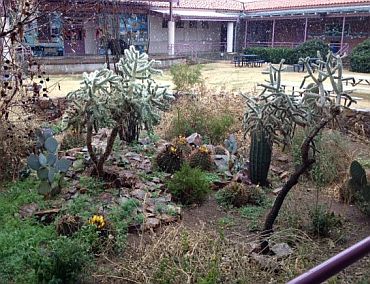
Desert tortoise habitat created on the grounds of Manzo Elementary School.
Manzo's Reconciliation Ecology project is led by Moses Thompson.
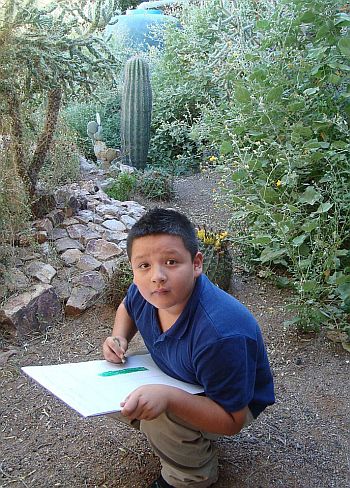
Angel in the desert tortoise habitat.
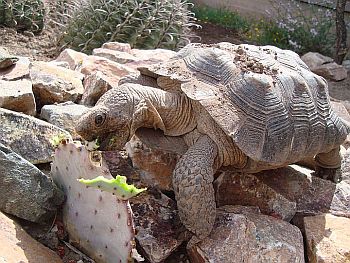
Desert tortoise eating Opuntia in the habitat.
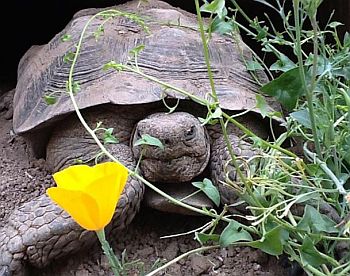
Desert tortoise closes in on a Mexican gold poppy.
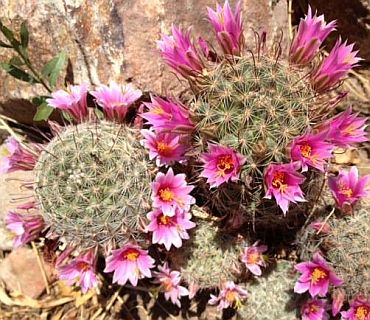
Pincushion cactus blooming — at last!
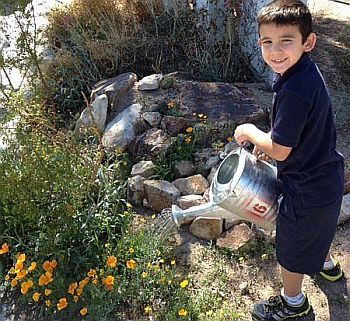
Getting the wildflowers through a dry time.

A smoketree blooms next to the school fence.
|






